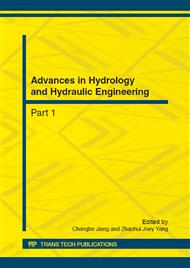p.3
p.10
p.20
p.25
p.33
p.40
p.46
p.50
Study on Flow and Sediment Diversion at Four Inlets of Dongting Lake and Tendency and Influences of Erosion-Deposition Variation
Abstract:
Through analyzing 50-year hydraulic data and by means of water-sediment model of middle reach of Yangtze River for numerical simulation calculation, it studies flow and sediment diversion at Four Inlets of Dongting Lake and tendency and impacts of erosion-deposition variation, and predicts the conditions of Three Gorges Project after 30 years’ operation. It can be found that flow and sediment diversion at Four Inlets of Dongting Lake are decreasing and the zero flow period is constantly prolonged. River courses at Four Inlets and Dongting Lake continue to deposit and shrink, and the problem of water resource in the Dongting Lake area is becoming more serious than before. Operation of the Three Gorges Project has not changed this trend and with the time of the operation goes on, the trends of flow and sediment diversion and erosion-deposition at Four Inlets river courses and Dongting Lake will be more detrimental to the water resources in the Dongting Lake area and its problem will continue to deteriorate.
Info:
Periodical:
Pages:
10-19
Citation:
Online since:
October 2012
Authors:
Price:
Сopyright:
© 2012 Trans Tech Publications Ltd. All Rights Reserved
Share:
Citation:


